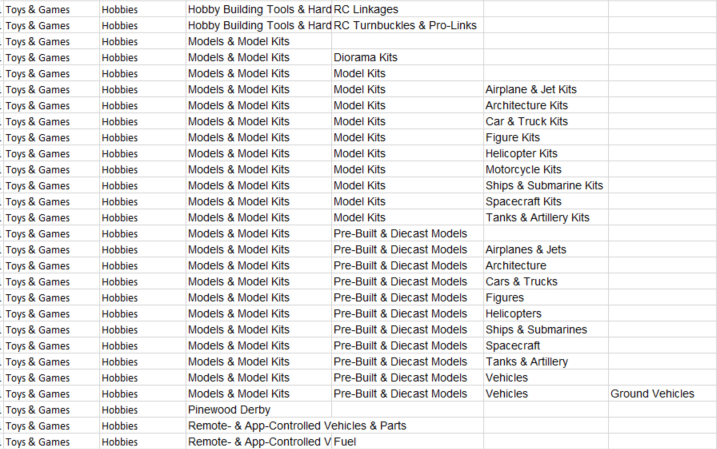 Reading Time: 4 minutes
Reading Time: 4 minutesFirst, let’s review what ‘taxonomy’ means when we apply the word to a website. The basic definition of ‘taxonomy’, according to Merriam-Webster, is “the study of the general principles of scientific classification” and, more specific to the world of science, it is defined as “the process or system of describing the way in which different living things are related by putting them in groups.” However, in the purpose of being used for a website, Google would define it simply as “a scheme of classification.” Personally, I would define a website taxonomy as:
“The hierarchical structure of a website as it relates to what is on the site (content, products, etc.) and how that is meant to be delivered to the site’s users.”
Essentially, we mean that it looks at the highest level of messaging (think your homepage) and then gradually dissects the website based on consumer purpose and the informational hierarchy of the market(s) it is meant to service.
One of the greatest product taxonomies on the internet is what Amazon has created to classify the millions of products and product varieties they sell in “Browse Tree Guides” and all the content associated with explaining it as well as shown below:

Because of this, Amazon is now where 50% of shoppers start their product search. This only happens when product shoppers feel comfortable with how to find the products they are looking for and, which is definitely true for Amazon, they can easily see a variety of products that fit what they are looking for. Once this is done, they may look for a more local source to get what they want or, since it was so easily found on Amazon, they may just buy it right there.
The key to what makes a taxonomy powerful, is that it can be built for the present, but even with the right experience, be built for the potential short, medium and long horizon expansion targets of an organization. What defines a good taxonomy is the sense of simple organization, by level, that is also mapped to how individuals use language to describe things they are looking for. This last sentence describes why this becomes powerful for search engine optimization of a website…go read it one more time. The words assigned at each level of a taxonomy…the words…after all, that is the basis of what search, SEO or otherwise, is meant to target, the words.
A true SEO taxonomy can be described in words and, almost anyone, should be able to understand the increasing specificity. As an example, think about how your brain auto classifies everything when you hear the word ‘car’. That single word immediately eliminates vans, SUVs, trucks and motorcycles. Now, take that word and imagine that the level above it was ‘toys’. All of a sudden, the word ‘cars’ immediately conjures up the image of toy cars, or, for someone my age, of Hot Wheels and/or Matchbox. A good taxonomy not only provides the instant cognitive recognition of where they are, but of what options would be above that and the potential options that would be below.
When it comes to SEO taxonomy, the user HAS TO BE put first, not the keywords. The keywords and phrases will follow, so, the first step is to define your hierarchy based on the common language that relates to your website. To provide a real life example from Amazon itself, just click and download their taxonomy for “Toys & Games”. Below I show that spreadsheet from Amazon with the “Node Path” dissected to show a more visually digestible format to look at it.

As you can see, I pulled the section that shows even more classifications using the word ‘cars’, yet, by seeing “Hobbies > Models & Model kits” you can quickly and easily digest what exactly you will find in this area as a shopper. For a machine programmed by humans to digest context via labels, this sort of thought through website taxonomy does the same thing. Additionally, when truly thought out, you can more easily evolve it. Let’s say, hypothetically, that it becomes really cool to build skateboard model kits. Well, all Amazon needs to do, is add that to the “Model Kits” node right there along with “Spacecraft Kits” and individuals will immediately know where to find them. Google and the other search engines immediately understand the difference between these skateboard kits and a real, full-size skateboard.
So, before I get too deep into this (I could talk about taxonomies all day), you should be able to get the context now of why this is a great exercise for any website. Many websites have grown organically through in-market expansions and they have not always taken the time to revisit how those new product lines fit into the mix.
So to wrap this up with a last “special-sauce”, when it comes to a website and building in the SEO layers through the use of descriptive language, the key is maintaining a consistent internal linking structure AND leveraging your own knowledge of your business to influence those organically obtained links across the web. Always assign each node of the category a ‘primary’ and ‘secondary’ keyword and make sure people know and/or have access to that list. Got a blog writer whose job it is to talk about new and hot seasonal products and product categories? Make sure they have the taxonomy so they can reference it for which word or phrase is mapped as the primary or secondary term so when they build a reference in their article, they are linking the RIGHT descriptive phrasing for whichever category they link to.
So, when was the last time your company did a true review of your website’s taxonomy? If the answer is more than 5 years ago, it may very well be time for an update. If you can’t even find the original documentation for your website’s navigation, well, that would be another indicator that it is time to re-evaluate it or, if it is good, at least re-document it.
Also check out:
Taxonomy, IA, and SEO
Google Chrome’s Plan to Distrust Symantec Certificates
Tool Tip Tuesday: A Look at DeepCrawl
At Vizion Interactive, we have the expertise, experience, and enthusiasm to get results and keep clients happy! Learn more about how our SEO Audits, Local Listing Management, Website Redesign Consulting, and B2B digital marketing services can increase sales and boost your ROI. But don’t just take our word for it, check out what our clients have to say, along with our case studies.
What is website taxonomy and how does it relate to SEO?
Website taxonomy refers to the hierarchical structure or categorization of content on a website. It helps organize and classify information, making it easier for users and search engines to navigate and understand the site's content. A well-optimized website taxonomy improves your visibility in search engines by grouping similar content, which helps build contextually relevant internal links and demonstrates your expertise in those topics.
Why is website taxonomy important for SEO?
Having an optimized and well organized site helps builds contextually relevant internal links by making use of the site’s menu and navigation systems. Clustering similar topics and pages together also helps demonstrate to search engines that you have a body of content on a specific topic which is one of the ways you can also demonstrate authority.
How does a well-structured website taxonomy improve user experience?
The names or labels for each section of content makes it clear what topics it might contain and the type of content. This makes it easier for people to understand how the site is organized and helps them navigate to the content they want with fewer clicks. While we want our content to be engaging and have people stay longer, the navigation needs to get people to the content quickly and with as few clicks as possible to avoid frustration.
What are the key elements of a good website taxonomy?
A good website taxonomy includes logically grouped and intuitively named categories, subcategories, and tags that accurately represent the site's content. It should be organized hierarchically, with clear relationships between different levels of classification and different types of content. Additionally, it should be scalable, flexible, and easily navigable for both users and search engines.
How can a well-designed website taxonomy help search engines understand my site better?
A well-designed website taxonomy provides search engines with a clear structure and organization of content. It helps their crawlers easily discover and crawl your site's content and through the built in menu and navigation structures, the taxonomy provides contextually relevant text links, which is one of the factors search engines use to help understand relevance of the page being linked.
What are the common mistakes to avoid when building a website taxonomy for SEO?
Common mistakes to avoid when building a website taxonomy for SEO include creating overly complex or ambiguous categories, using duplicate or irrelevant tags, neglecting to update the taxonomy as the site grows, and not considering user behavior and search intent. It is important to strike a balance between specificity and simplicity, ensuring that the taxonomy accurately reflects the content and is easy to understand for both users and search engines.
Should I use hierarchical or flat taxonomy for my website?
The choice between hierarchical or flat taxonomy depends on the nature and size of your website and your future plans to expand the content on the site. Hierarchical taxonomy, with nested categories and subcategories, is suitable for larger websites with diverse content – think of an ecommerce site with nested categories and multiple child category pages. It provides a clear organizational structure and makes it easier to manage and navigate through a large volume of content. Flat taxonomy, on the other hand, is suitable for smaller websites with simpler content structures where there’s no need to add layers of categories.
Can I change my website's taxonomy without negatively impacting SEO?
Changing your website's taxonomy can potentially have an impact on SEO if not handled carefully. It is crucial to plan and execute the changes systematically. Ensure that you properly redirect old URLs to the new ones, update internal and external links, and rebuild your XML sitemaps. The extent of taxonomy changes and the size of your site will largely determine the time it will take search engines to crawl and understand your new site. This can take anywhere from a couple of weeks to several months during which time you may experience a drop in organic traffic, however, there are ways and techniques that can speed up crawling and reduce this drop in traffic.
Are there any tools or plugins available to help with website taxonomy optimization for SEO?
There are keyword research tools and other plugins that can help optimize a page, but designing a site’s taxonomy is better done by experienced SEO consultants who will first want to understand your business, the content you have currently, and your future business and marketing plans, so they can design a taxonomy that can scale and allow your business and site to grow, minimizing the need to make major structural changes later on.




